

Imagine a robotic arm that doesn’t need mechanisms to move, or surgical tools that can expand or reshape themselves inside the body. While they may sound weird and wondrous, they actually already exist.
These wacky instruments all rely on shape-memory polymers, a category of materials that can shapeshift on its own. Now, researchers at Stanford University have made a shape memory polymer that’s stronger and more capable than any of its counterparts that came before it. They published their work last week in the journal ACS Central Science.
“[Shape-memory polymers] have been commercialized in our lives for a while,” says Shayla Nikzad, a graduate student at Stanford University and one of the paper’s lead authors.
A polymer is a very long molecule, built from many smaller molecules linked together in a giant chain. It’s no exaggeration to think that polymers run our world. The DNA behind the scenes of your cells is a polymer; silk and gelatin are also made of polymers. In your everyday life, you’re likely to happen across human-made polymers that make up plastic and synthetic rubber.
Shape-memory polymers are a very special type of polymer. When you bend them, the molecules in the polymer form some special bonds. And when you expose them to some stimulus—light, electricity, or, most often, a shift in temperature—those bonds will break and snap the polymer back into its original state.
In other words, shape memory polymers “remember” their original shape, and can reshape themselves back into that true form. Many engineers find that ability irresistible.
“So we can use shape-memory polymers to create a device … that changes shape without having to actually be pulled or stretched,” says Kai James, a professor of aerospace engineering at the University of Illinois Urbana-Champaign, who was not an author on the paper.
If you’ve ever played with a Shrinky Dink, you’ve seen a shape memory polymer in action. When you put one in the oven, it’ll shrink and harden. Of course, you can’t easily undo a Shrinky Dink after that; indeed, many shape memory polymers only “snap back” in one direction.
But shape-memory polymers are quite a bit more than just toys. In many ways, they’re already shaping the world around us. Some wires have a shape-memory coating that can shrink to give the wire better insulation. Shape-memory polymers in fabric can make it more breathable when hot and more waterproof when cold.
[Related: We finally have a working supersolid. Here’s why that matters.]
Researchers are also working to deploy shape-memory polymers in the hospital, for things like self-stitching sutures and stents that can fit into arteries and then expand, helping to increase blood flow.
Nikzad and her colleagues are especially interested in putting shape-memory polymers to work in robots. By creating artificial muscles from them, they could make robotic arms that don’t need heavy mechanisms like machinery or actuators in order to move.
“But one of the major roadblocks,” says Nikzad, “is just the fact that the materials essentially are not very strong.”
Engineers could use shape-memory polymers to build a robotic arm that’s lighter and more flexible than its mechanical counterparts, but it wouldn’t carry as much without fracturing and falling apart. And shape memory polymers returning to their original state don’t provide very much force that can move or lift objects.
It’s possible to make stronger shape-memory polymers, but there’s a tradeoff: They can only act over lengths that are too short for most robots. Picture a high-technology version of Tyrannosaurus rex’s tiny arms.
The Stanford group wanted to see if they could do something about this conundrum. Working with chemists such as Stanford graduate student Christopher Cooper, the paper’s other first author, they took an existing polymer called PPG—today used to finish leather and to make paintballs—and modified its atomic structure to help its atoms form better bonds, thus creating a brand- new molecule.
“That’s your run-of-the-mill organic chemistry,” says Nikazad.
When they tested it, they found that they’d created a new material that was capable of storing six times as much energy as any previous shape memory polymer. A plastic muscle made from this material can lift objects 5,000 times its own weight—and it’s not prohibitively expensive: The raw materials cost about $11 per pound.
“What these researchers have been able to do is overcome the tradeoff,” says James.
The researchers want to continue to work on their materials. For instance, their polymer’s shape-memory effect only works in one direction. That’s something they think they can improve upon. “For example, you could make something that heats up and it stretches, and then cools down and shrinks,” says Nikzad. This process repeats no matter how many times you heat or cool it.
That, certainly, could create stronger, more lightweight robots. Beyond that, according to James, with the wide variety of applications that shape-memory polymers already have, the Stanford group’s new materials could be used in a good deal more than just robots.
